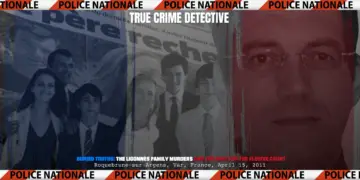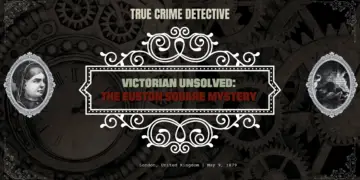
The Burton Crescent Mystery
In our last story, we delved into the Euston Square Mystery, where Hannah Dobbs was suspected of murdering a lodger at the house where she worked. The story enthralled the Victorian press with sensational claims of multiple killings, love affairs, and vile brutality. However, it wasn’t the only mysterious killing in Bloomsbury during the era.
Just a ten-minute walk away, Burton Crescent was, like much of Bloomsbury, transforming from a professional and middle-class area into one where lodging houses were beginning to become prevalent. By the 1870s, the area was potentially dangerous, with brothels popping up and the kind of characters that Whitechapel was far more famous for started to appear in the locality. This change in the atmosphere brought a new level of crime to the area, with the Euston Square victim Matilda’s Hacker vanishing in 1877 and the first Burton Crescent Mystery in 1878. It would be far from the end, with The Harley Street Mystery in 1880 and the Second Burton Crescent Mystery in 1884. All women, all murdered, and all officially unsolved.
Rachel Samuel lived alone at 4 Burton Crescent. She was a widower, surviving her husband, the Jewish jeweller Lyon Samuel. Lyon Samuel’s wealth had allowed the couple a big house, and Rachel could still maintain the house in her old age. She was 74 and employed a single servant, Fanny White, during the day, with her three adult children living elsewhere in the city. To help with the house’s upkeep and perhaps to keep a presence in the spacious house, Rachel let a back parlour and top-floor back room to John Borchidsky, a theatre musician who had lived there for two years. Another lodger, Cooke, had left some time ago,
Before the current arrangement with Fanny White, Rachel had employed Mary Donovan as a live-in servant, a widow with two children. After three years in service, Mary had left the house to marry again and now lived at Lancaster Street. Despite this, she still called to help wash and visit her mistress. While the household was large, it was not an especially lonely house, with a regular cast of characters that knew each other well.

On December 11, 1878, this domestic regularity would be shattered. The day initially seemed like any other. Around 4 pm, two workmen appeared at the house, John Goodyer and his apprentice Thomas Bear, having been previously engaged by Rachel. Once done, they went upstairs, and Rachel let them out, with nobody else seemingly in the house then. After this, Mary Donovan came for one of her regular visits late in the afternoon, as she had alongside her sister, Kate, the previous day. On that occasion, Mary was said to have been intoxicated.
Meanwhile, early in the evening, two women called looking for work. They were let into the house by Rachel, who saw them into the kitchen. The three talked for around fifteen minutes, and Rachel said she needed some needlework and would call on their services. At this time, the two women, Elizabeth Browne and Louisa Jane Shillito noticed that Mary Donovan was also there in the kitchen.
Later statements would disagree on who let the two women out, with Mary saying she showed them the door, still at the house around 8 pm. The women would say that it was Rachel who let them out. It is here we find a key missing for four hours.
It was midnight when John Borchidsky returned from the theatre. Feeling peckish, he headed downstairs and into the kitchen, searching for Rachel. He found her dead. The large pool of blood surrounding the body made this quite obvious, as did the huge blood splatter on almost every surface. Horrified, Borchidsky ran from the house to raise the alarm, seeking out Judah Samuel, who was Rachel’s son, a doctor, and a police officer. More constables soon arrived on the scene and found a truly horrific scene.
A Scene of Brutality in Burton Crescent
Rachel Samuel was lying on her back on the concrete floor. Her face was heavily bruised, with extensive hand and arm defensive wounds. The force of the blows had been immense, and blood splatter will have shown the force with which the individual rained down blows with a heavy instrument. One last attack to the back of the head had finished the job, with a jagged wound possibly caused by a nail. The time of death fell into our missing four hours.

Investigating the scene, police soon found the murder weapon — a hat rack that had once been attached to the wall with nails. The pegged rack had broken in two with the force of the assault, with blood and hair matted onto it. Investigating further in the house, police discovered that was blood on the back door and on the stairs and a broken window, the trail perhaps telling a tale of Rachel being attacked first at the stairs and attempting to flee through the kitchen and out of the back, with an intense struggle taking place despite Rachel’s advancing years.
Interestingly, police discovered that the killer had attempted to clean both the murder weapon and the floor with a horse flannel, with a sink showing that they’d also washed their hands. While washing the hands would be logical if the murderer intended to go out into the street, the attempts to clean the location suggest that covering up the killing had crossed their minds before they realised such a thing wasn’t feasible. Rachel’s son also said she wouldn’t have let any stranger into the house after dark, being careful always to put the chain up when she answered the door.
While some loose change, felt boots, and a wedding ring had been taken from the body, police weren’t entirely sure this was a simple robbery with nothing else being taken from the house. They found no evidence that there had been a burglar present, with the window having been broken from the inside. Instead, they believed that Rachel had let her killer inside the house or that they already had a key. Borchidsky Had such a key, but witnesses definitively placed him at the theatre for the time of death. With Fanny White having long finished work before 8 pm, this left Mary Donovan.
Mary had a reputation for drunkenness and had heard a sharp tongue from Rachel Samuel the day before the killing. Police saw her as a woman of low morals and an ideal suspect for the murder. During an interview, Mary admitted being at the house, claiming that she came to ask about her sister’s address and doing a few errands for her former mistress, such as cutting her toenails and shopping for fish. She easily remembered the two women looking for work, and after speaking to Rachel, she also remembered showing them out. Mary then revealed that after this, another person came to the house, a man. The man was seemingly interested in acquiring lodging at the house, and Mary said he was still there when Mary left at 8:30 pm.
Police were suspicious of the claims as too convenient, passing all blame to a mysterious man Mary couldn’t name. Police subsequently asked to see what Mary had been wearing, which they were informed was her current attire. The police pointed out a stain that Mary claimed was rust, and upon searching the house also found a skirt that was seemingly stained with blood. However, the testimony of her landlady truly pointed the finger at Mary, claiming that she had been waiting until midnight for her to return on the night of the murder. Mary hadn’t returned until nearly 8 am after discovering the body. Mary Donovan was promptly arrested for the murder of Rachel Samuel.

More witnesses began to come forward to strengthen the evidence against Mary. The workmen confirmed they were at the house until 5 pm, repairing doors and locks and confirming that the broken window had been intact. The two women also came forward and stated they had left the premises around 8:30 pm, the same time Mary claimed she had left, despite claiming a man came to visit after the women. Mary’s sister added to the woes, revealing that she’d visited recently, so clearly knew what her address was, and when police believed they’d placed Donovan at a pawn shop with a ring belonging to Rachel, trying to pawn it under the name of Ann Donovan.
However, when the ring was presented to Rachel Samuel’s sons, none recognised it and pointed out it was probably too small to have belonged to their mother. Indeed, her sons all said that Rachel and Mary had a great relationship beyond Rachel, often being upset at her drinking. Yet, the police still had the clothes, and forensic analysis confirmed that the blood wasn’t rust but blood. The case still seemed secure.
The Case Collapses
On December 29, Mary Donovan first appeared before a court at Bow Street, and the courtroom was sent into almost immediate disarray when the pawnbroker’s assistant, who’d first identified Mary as the woman who had brought in the ring completely upended his statement and now said that it wasn’t Mary who had been in the shop. If that was an upset against the police, it went from bad to worse when it was revealed that a woman named Ann Donovan had been tracked down and had confirmed that she had recently pawned her ring.

Fearing things might slip away, police doubled their efforts to find Rachel’s boots. They continued to find witnesses, including those who would confirm that Mary had indeed been out all night when Rachel was murdered and had looked dirty and messy, and was carrying some kind of parcel under her shawl. By June, the police had completely exhausted their inquiries, unable to find more evidence against Mary Donovan. Without being able to place Mary at the pawn shop and the ring unlikely to have belonged to Rachel in the first place, the case would not even be brought to trial, despite expert testimony that the blood on Mary’s clothes was recent and showed signs of being spurted and then wiped over.
The famously rabid London press had long decided that Mary Donovan was guilty, having published drawings of her in the act before court proceedings had even begun. Her dismissal from the case left that somewhat muted, instead lamenting the state of criminal investigation in the city rather than the fact she was now free. With no other evidence or suspects, the case quickly went cold, despite offering a reward for information.
With that said, there were two other people of some moderate interest. During proceedings against Mary, a drunk, Joseph Perkins, came forward to confess, claiming to have Rachel’s boots in his possession. He claimed to have been a workman at the house and worked as a plasterer. However, his drinking was to such an excess that he was suffering from delirium, and when he was made sensible, he was shocked to have confessed in the first place. He had nothing from the Samuel household, and the incident was considered a hoax. Later, in 1880, another confession was made, this time by James Wells. Wells claimed he had acquired a skeleton key and used it to secretly enter the house. Wells was a clear fantasist, claiming to have strangled Rachel and used a dishcloth to wipe the blood off the floor, both untrue.
What Happened At 4 Burton Crescent?
Despite Mary walking away from the possibility of a trial, it seems she either murdered Rachel Samuel or at least knew more than she knew. The reasons that she was out till morning following the murder were never truly explained, nor how the blood came to have been on her clothes. Equally, it seems that the murderer had attempted to clean the scene, which would have been highly unusual for a home invasion. Finally, it was known that Rachel would never have let a stranger into the house, and Mary was known to have been at the scene before the murder.

However, some points stand against the possibility, including what happened to the things stolen from Rachel’s body. Despite initial police suspicion, the ring was never found to have been pawned, and the boots were never found. Equally, nothing else was stolen from the house when an impressive sum was there for the taking. Could Mary have worked with somebody else? Or was she innocent entirely? Perhaps the workers were involved? Or even somebody else entirely?
Or could it be that Rachel was once again berating Mary on her drunkenness, and she simply snapped? Losing control, she grabbed the nearest thing to hand and swung it at her former mistress. Once the assault had begun, Rachel started to fight back, and things got completely out of hand. Mary Donovan probably didn’t intend to kill Rachel, but the nail on the hat rack did a job she never intended. While Mary was small and sickly, the addition of a weapon likely aided her, though it must be said there was no evidence that Mary had ever become violent when drunk.
Perhaps what she’d done brought her momentarily to her senses, taking the ring, money, and boots to make it look like a robbery gone wrong. Perhaps she even broke the window deliberately, not realising it would be obvious it had been broken from the inside. It’s also not unusual in killings where the victim is known to the killer for the culprit to try and clean the scene, with them psychologically ashamed and trying to erase what they’ve done.
While this theory may sound plausible, it has to be remembered that there wasn’t enough evidence of it to even take Mary Donovan to trial, and she walked back into her life with a stain on her character. Sadly, there was to be no justice for Rachel Samuel, so brutally murdered in the safety of her own home.
















































